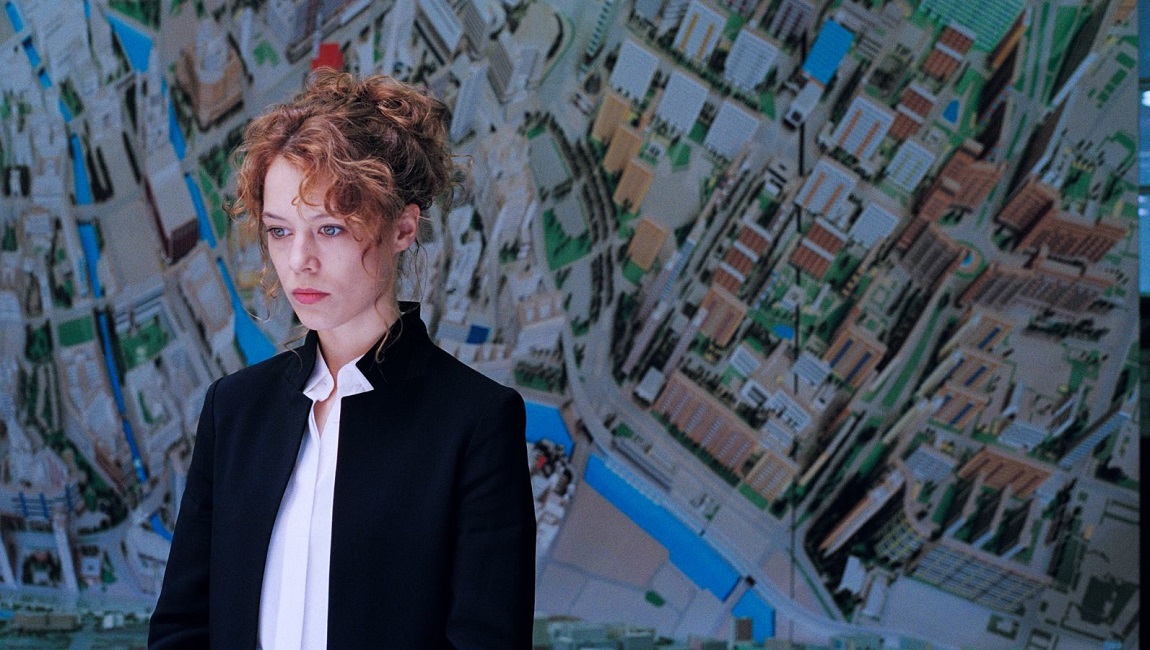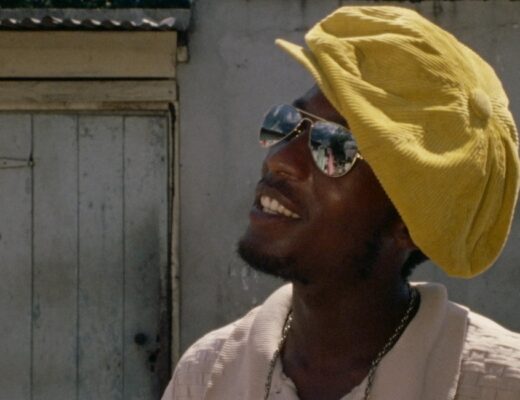In the cinema of the filmmaker Christian Petzold, it’s not hard to notice a motif of water that stands out across his work and often plays a crucial role. Whether it’s the seaside (in The State I Am In, Jerichow and Barbara), lakes and ponds (in Gespenster and Yella), or the harbor city of Marseille (in Transit), such locales have always been present in the topography of Petzold’s work — indeed, his debut theatrical feature, The State I Am In, opens to the sounds of waves and seagulls. Such places can be where the director’s characters stem from or where they wind up, and they certainly crop up in the world around them. And so it always seemed likely that sooner or later Petzold would craft a new project that puts at the fore this elemental force and more fully investigates his mysterious fascination with it. Undine, for now, is that film, with its very title vividly recalling the ancient myth of a water nymph who’s destined to kill her earthbound lover if he ever betrays her, or otherwise, she can choose to save her beloved’s life if she’s willing to sacrifice herself.
And so, viewers already familiar with the Undine legend perhaps know what to expect here, but the uninitiated may be a little perplexed with what’s happening in the film’s early stages — particularly in the opening scene, where the titular character (played by Paula Beer) warns her (ex-)spouse, “You can’t go. If you leave me, I’ll have to kill you. You know that.” Minutes later, we find out Undine Wibeau is a historical guide who works for the Senate Administration of Urban Development in central Berlin, which connects her to many other Petzold characters who share some strong similarities with Walter Benjamin’s interpretation of Paul Klee’s painting, Angelus Novus (New Angel.) It’s no wonder then that Undine is also one of those phantom, revenant-type female protagonists who appears as an eternal witness for modern-day Germany after WWII, the country’s reunification, and its post-capitalist era — a texture which ties Undine more to Yella than any other Petzold work. The question, then, is how much of this relationship between the eponymous mythological character and the contemporary post-industrial urban landscape is tightly, cogently woven here or how much remains raw sketch? Nothing is ever entirely settled in Petzold’s films, but the answer seems tilting more toward the latter, as not much is made of this connection that doesn’t stay fixed on the surface, where characters appear to be living, moving, talking, and acting in a loop within the cityscape, or in scenes where Undine lectures about Berlin’s history — in a similar manner to the experimental and discursive documentaries of Petzold’s deceased mentor and collaborator, Harun Farocki.
Undine marks the Berlin-School veteran’s departure from his previous three works, which he refers to as the trilogy of “Love in the Time of Oppressive Systems,” and in so leaving the historical context of those films, opts for a more mysterious fairy tale atmosphere. Undine partly divides its narrative between two men, Johannes (Jacob Matschenz) and Christoph (Franz Rogowski), and in doing so, arguably wastes part of its latent, potent energy and hampers its effectiveness. The relationship between Undine and her two different paramours is largely underdeveloped and schematic. Much of this can be attributed to the fact that instead of creating tangible and dimensional characters — which Petzold has proved duly capable of in his better films — the characters here are largely manufactured as symbolic entities or representatives for their social classes — Johannes, a carefree bourgeois; Christoph, a hard-working industrial diver; and Undine, an ambiguous, otherworldly woman. InRO critic Daniel Gorman, in his meticulous introduction for this retrospective, mentions how Petzold’s filmic world always shapes and constitutes itself “in the cut.” This can certainly be said of Undine too, but here, unfortunately and perhaps more than ever, this “neither/nor” or “in-between” strategy hinders Petzold’s ultimate aims. This gap — between a classic fairy tale and a modern ill-fated romance, between the mythological and the mundane, between the material’s emotional melodrama and Petzold’s cold, even distant realism (not unlike the general character of a Dardennes film, for instance) — neutralizes the film’s two contradictory forces rather than enabling them to enhance the other, which keeps things affixed to a safe, stable point rather than ascending to any matching mythical heights.
In something of a break from Petzold’s general style, Undine seems more concerned with (narrative) structuring than in engaging emotionally or intellectually with specific scenes or moments — for instance, Undine and Christoph share several short meetings, get on and off trains, share some minor romantic rapport and dry-toast dialogue without ever actually suggesting a convincingly profound love affair that would justify their final, radical sacrifice for each other. Part of this can be understood in the peculiar way Petzold treats different scenes as various separated narrative blocks/units or interrupts them before the insemination of feelings or meanings that ultimately, typically, result in a gestalt. We can call this systematic approach his “coitus interruptus” style, as it’s also a recurrent, literalized motif in many of his films where the amorous acts of the couples impeded — love-making in the woods in Barbara, in silent corridors of the home in Jerichow, between the two female leads in Gespenster, and here, when after an aquarium suddenly explodes, a waiter walks in to disrupt Christoph and Undine who are lying on a wet floor in the midst of some romantic or sexual tension, or when Christoph later asks her to recite her lecture while they’re in bed. But this “push-and-pull” strategy comes with both strengths and drawbacks: at its best, it enriches interactions, tensely leading viewers into what’s next, while at its worst, it delays and withholds, a prolonged stall, until some final climax. Undine again skews toward the latter of this either-or, made more obvious in how Petzold forcefully and repeatedly insists on binding these scattered narrative blocks via the aid of an uplifting musical piece, Bach’s “Concerto in D minor.” It’s nothing strange, as Petzold has been using classical music in tandem with the worlds he builds since at least Gespenster or Yella, but here, it’s a trait that feels distinctly outmoded, a simplistic technique that seems designed to conceal the absence of the director’s usual emotive and contemplative depth.
And so, while it’s possible to criticize Undine for its serious lack of spirit (in a Hegelian sense), it’s harder to be ambivalent to the way Petzold handles the materiality of the film. Thanks to his long-time DP, Hans Fromm, he still demonstrates his formal vision in articulating some gorgeously taut, well-composed shots (and to a considerable extent, their familiar unfussy and neat character works with better integrity in depicting a modern city than in his recent historical milieus). While known as a director who works in close tandem with his actors, Petzold seems here more dedicated to Beer and Rogowski’s surface charisma and physicality above all else — capturing characters lying on beds, of fixing on their gestures as they embrace or exchange glances is a persistent photogenic ingredient of his particular aesthetic across the past two decades. In other words, these are fragile characters defined more by their appearances than any acts or words they offer. That half-mustered fragility is echoed in the film’s inexplicably metaphorical moments, such as when an aquarium, a leg of a diver statuette, and even a glass of wine breaks — but such instances do not present themselves as anything more than banal symbolic objects to be decoded or else as “empty signifiers” for the viewer to impose meaning upon.
But all of that is not to dismiss Undine outright, and as an atmospheric, gauzy mystery, it works well enough, while never ascending to quality and rank of the director’s best work. There are still interesting ideas to parse both thematically and conceptually, and it offers plenty of fodder for further cinephilic discussions and academic readings. Perhaps most telling of its essential character is that while many will find the final references to Mizoguchi’s Sansho the Bailiff or the Orphean underwater scene quite striking, it’s not unfair to also see some of the superficiality of Del Toro’s The Shape of Water in the film’s fabric as well. Fortunately, it’s reported that Undine is going to be the first entry in an upcoming trilogy about fairytales and myths, and thus plenty of the hit-or-miss ideas found here can reasonably be improved upon in successive efforts — or perhaps even suggest the need for a critical reevaluation of Undine itself. Of immediate import is that Undine does enough to keep Petzold stans enthusiastic and curious for the upcoming works from one of the most important living directors. To borrow something of Petzold’s aquatic symbolism, even if Undine fails to fully submerge viewers in the way we have come to expect from the modern purveyor of intellectual melodrama, it at least manages to be an easy-flowing and refreshing work capable of sustaining us until his next (fabulist) effort.
Part of Christian Petzold: In the Cut







